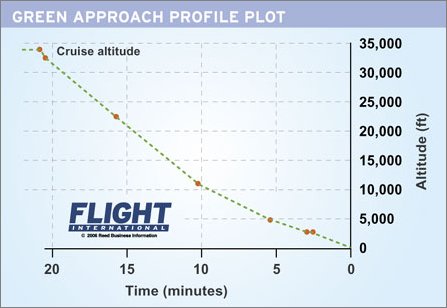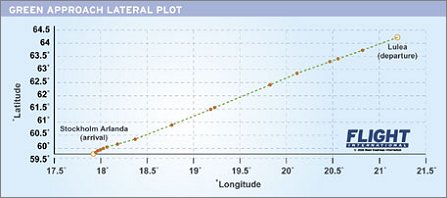In-service experiments in Sweden are showing how future controllers could know precisely when aircraft will arrive – helping airports and the environment
For the first time since leaving the cruise 20min earlier, Scandinavian Airlines (SAS) Capt Christer Staaf makes a meaningful movement of the throttles on his Boeing 737-800, deploys the landing-gear and flaps, and shortly after touches down at Stockholm Arlanda.
The flight has used 200kg (440lb) less fuel than usual, generated less noise and pollution, and is just 2s later than air traffic control (ATC) and SAS have been expecting for the last 45min.

Staaf’s landing marks the end of the airline’s regular operation SK007 from Lulea 690km (370nm) to the north, but today, on 19 January, it is also the completion of a historic flight in which the crew of a revenue-service aircraft has negotiated with, and then shared its precise intended trajectory with, air traffic control (ATC).
The result is a near perfectly optimum flightpath from take-off to landing, incorporating what SAS and Swedish civil aviation authority LFV have christened a Green Approach – more formally known as standard arrival (STAR) HMR1N.

Used routinely, the techniques would cut air transport’s environmental impact and simultaneously improve airport capacity – both critical to the industry’s future.
With the estimated time of arrival (ETA) of all flights known to within a few seconds, aircraft could be accelerated or slowed in the air, or even held at the gate, minimising wasteful in-flight vectoring and holding, and enabling optimised planning by the airline and airport authorities.
Trajectory downlink
At the heart of the concept is the downlinking of the aircraft’s four-dimensional trajectory (4DT) from its Smiths flight management system (FMS) to the controller, complete with highly accurate ETA – and the subsequent datalinked negotiation of any changes and generation of revised ETAs (RETA). The datalink currently used is the airborne communications, addressing and reporting system (ACARS), but alternatives could be used – notably VDL-2 and VDL-4 – and will soon be tested.
Although the core technology has been previously demonstrated, SAS is now taking the first small steps towards moving it into service. Staaf’s flight took place before an invited audience at Stockholm’s new ATC centre, which was able to watch a representation of the LFV’s sequencing and information-sharing tool, called the Collaborative Information Exchange System (CIES.)
This tabular display primarily shows arriving flights with their ETAs and intended STARs, which are constantly updated – automatically on receipt of the 4DT in the case of the SAS flight.
Stockholm ATC managers showed how SK007 had a planned ETA of 10:00 before departure. As soon as it lifted off, however, the Smiths FMS automatically datalinked an initial trajectory based on the known instrument departure in use, the runways in use, and assuming the longest STAR at Arlanda – which generated an ETA of 10:08 on CIES.
After a 5min delay to avoid overloading pilots during their busy post-take-off period, ATC datalinked back the expected STAR, which the pilot reviewed, accepted, and inserted in the FMS, which promptly calculated and transmitted a new trajectory giving a RETA of 10:03.
Although even domestic trajectories consist of as many as 10 waypoints and for now have to be transmitted as free-text messages, most are standard company routeings that can be rapidly inserted into the FMS from a menu of routes.
Seeing the latest RETA, the controller decided that the Green Approach could be utilised, and it was offered to the crew and accepted via ACARS. That acceptance also told the controller the top of descent time and might have generated another RETA. In the event, the aircraft landed on runway 19R at the latest RETA almost to the second.
Staaf says: “From flight level 340 about 100nm out, we had almost total idle power setting and saved about 200kg of fuel on the descent. And it was almost the shortest way you can fly this route. From the top of descent it was a continuous descent, which is also very nice for the crew.”
He describes how the RETA was hit despite a strong tailwind en route, which required an early descent, and then a similarly strong headwind on approach. “The headwind put us back 19s late, but we just corrected a bit and left the flaps a bit late so at the threshold we were only 2s late,” he explains.
Staaf adds: “The workload is nothing to talk about. There is much less voice communication because of getting the clearance early. This was very much a silent approach, which gives you time for safety procedures and [instrument] scan-flow.”
Taken in isolation, the benefits of 4DT on this flight were limited to the immediate economic and environmental gains, but used routinely they would extend into airlines’ ground operations – for example improving gate and staff utilisation.
Potential gains
For air traffic management the concept could be transformational, and the potential gains are greater the busier the airspace and the worse the weather. In poor weather the fuel savings are also magnified as radar vectoring is greatly reduced, pushing the gains up to 200-300kg per flight, SAS estimates.
SAS project leader Peter Larsson says: “The system at present is more or less first-come, first-served. ATC says that, since you are all so unpredictable, we will just handle you when you come in, and you come in when you come in. But there is much common ground among the needs of the different actors – ATC, airlines, passengers, the airport, residents, and the authorities. The FMS offers a lot today to address that. The FMS is the key.”
The project is known as NUP2+ and is the latest, €16 million ($19 million), element of the European Commission’s long-running North European automatic dependent surveillance – broadcast (ADS-B) network (NEAN) programme. Stockholm-based consultancy Avtech, run by SAS line-pilot Lars Lindberg, is handling the operational validation.
Lindberg explains: “It is very important to get things into operation, but it is even more important what we learn.”
He notes that, in addition to the operating benefits, the system brings some degree of safety advantage by helping avoid conflict situations. Lindberg explains: “As the future path of the aircraft is known in advance any unsafe condition, for instance conflict with other aircraft, terrain or weather, can be detected before it becomes a safety issue. And the workload for both pilots and controllers is reduced. In today’s system with its short prediction times, the ‘putting out fire’ approach causes both incidents and accidents.”
All of SAS’s 38 newer 737s have the updated Smiths FMS (v10.6) needed for the 4DT work and six are to be fitted with an electronic flight bag interface and Rockwell Collins multi-mode radio, which will permit use of other datalinks, including the Swedish-developed VDL-4.
Similar work is to be done using Lauda Air aircraft in co-operation with Austrian ATC agency Austrocontrol at Vienna and, in April, six 737s will fly 4DT operations together at Stockholm to study interactions between multiple aircraft and ATC.
Even though widespread use of the concept is years away, those involved with the Swedish work note that SAS accounts for 40-50% of Arlanda movements, so that significant benefits could potentially be had just by equipping the airline’s own fleet – a crucial point in environmentally conscious Sweden.
Approach publication
In March, the constant descent approach (effectively the Green Approach) will be published as a Stockholm procedure, but it will probably be used only by SAS and in relatively low traffic conditions. Introducing the new concept to controllers is not without its challenges, but Stockholm ATC centre chief Kimmy Bech is optimistic.
“First, we have to communicate this whole operation to the staff,” he says. “Among controllers there is always a certain hesitation about new technologies and jobs. But this is not about jobs. This is new technology to meet customer requirements. That is what it is all about.”
KIERAN DALY / STOCKHOLM
Source: Flight International























